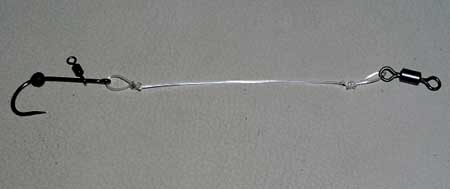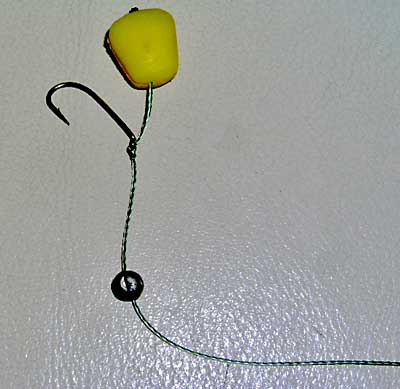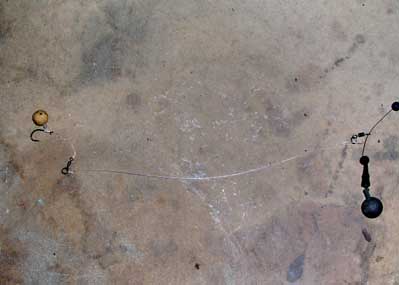People often talk on here about the “standard method” that gets used for tench, barbel, carp and often bream these days – hair rigged bait fished with a bolt rig – but the same can almost be said for hooklengths.
Reel in the rigs used on most lakes and I can almost guarantee that the vast majority of them will be a 6” combi link with the last cm stripped and the hook with a bit of curved shrink tube, hair coming off opposite the point of the hook and a 1cm gap between the bend and the bait.
And why not, it works. But how did we arrive at the “perfect” rig? And are we missing anything?
Here’s a slightly simplified “Brief history of hooklinks” – I don’t want to go totally into detail as to why and where they were used, but they might give you a few idea’s and it’s not a totally accurate timeline. A few bits have been missed out, but you’ll get the gist!
In the beginning, it was all about making the bait seem as natural as possible. 24” plus 6lb hooklengths with the hook buried in the bait to hide it (as we knew fish could see/sense the hook!) was the norm, offering the fish a large amount of movement. Paternosters were also used to give the fish more movement and also give bigger “twitches” that people, by and large, had to hit to strike the hook through the bait.
The next “development” was to use a larger hook and leave the point of the hook exposed to give more chance of the hook pricking. Sometimes “panickers” – trapped bits of biro tube – were added to the hooklength 3” or so from the hook to stop the fish taking the bait too far back into the back of the throat to avoid bite-offs.
Introducing – the “Hair”
Then along came the hair – probably the biggest thing to have ever happened in terms of making carp catchable. Initially the hair was anything up to 3 or 4 inches long of a very fine nylon (it was actually a human hair to begin with!), again to make the bait seem more natural. Hooklinks were still long by modern standards. Dacron also started to be used as it was softer and more flexible than nylon, also enhancing the “naturalness” of the movement of the bait. It was also quite common to balance the hook with polystyrene, anything to make the bait move as naturally as possible.

The Looped Stiff Rig
People then started looking at making fish panic to improve hooking, back stops that were added a foot or two behind the lead (the Shokka rig isn’t that new after all!) and slowly got closer and closer until the lead was fixed. Bites turned from twitchy takes to roaring off! Leads got heavier, rather than being just enough to cast as far as needed and hooklinks started getting shorter.
Braids started becoming more popular, again because of their suppleness, and hairs became shorter. People started chasing the “perfect” rig and rig’s like the “D-Rig” first appeared. Waters like Savay, Ashlea and Fox Pool started producing (or at least being fished by) real “thinking” anglers who were always looking for an edge as baits were largely flavoured balls rather than food, the answer had to be the rig didn’t it?
Pop-ups were popularised – they had been around as “suspended baits” for a while, but rather than being fished just under the surface (like the zig, another new rig? LOL!) the bait was suspended just off the bottom. The fish hadn’t seen them before, so catch rates picked up for a while although that might be because the hooking arrangement is more efficient with pop-ups.
Hairs carried on getting shorter, until they were only just long enough to get the bait on. Working on the theory that fish were mouthing the bait, backing off until they felt the lead and spitting them out. So by mounting the bait tight you were hoping to prick the odd fish as they held the bait in their lips.
Hooklinks also carried on getting shorter, but were still normally either braid or the same mono as the mainline. The rig developers came up with ways of extending the hook shank – the “Looney Extension” rig was developed to push the hook into the mouth before the bait, and variations combined with the “D-Rig” were developed. It also became essential to critically balance pop-ups.
I think I spent more time getting pop-ups to sink at 1mm per minute than actually fishing them! All to help the bait get into the mouth and surprise the fish.

The Swimmer Rig
The “swimmer” rig was popularised, predominantly for pop-ups. The hair came off the eye of the hook meaning that the hook was at a very aggressive angle, it also worked for bottom baits. It re-appeared tied slightly differently a year or so ago for bottom baits.
It wasn’t long before leads became heavier – much heavier! It wasn’t unusual to see 5oz ball leads, and very short hooklengths, even just a couple of inches to make sure they nailed any fish that came along. The infamous bent hook rig also appeared as the ultimate development of the “Looney Extension” theory, and adding a bit of hook “flip” to the proceedings.
The “Bungee” rig came and went, pole elastic was used in conjunction with fine mono to give excellent presentation and give the fish difficulty in shaking the hook out. The problem was the amount of fish lost in snaggy waters and the time spent playing the fish as you couldn’t really bully the fish. As an aside, Nash Tackle’s “Triggalink” is a pretty clever way around the problems of the rigs, as well as a neater solution.
Kryston’s “Multi-Strand” hit the scene, giving unprecedented levels of movement of the bait. Braids (again, mainly down to Dave Chilton of Kryston) started becoming more “custom” and designed for carp fishing rather than just being a braid that could be used for fishing. Jim Gibbinson developed the “Line Aligner” which helped give the same effect as the bent hook and all you would see on the banks was anglers dragging hooklinks over their palms to make sure the hook flipped. Just how relevant a palm is to a carp’s mouth when a carp is sucking and blowing I don’t know, but it seemed a good idea at the time!
Stiff rigs started to appear too – stiffer mono’s like the Brent brand had been around for a while, but using Amnesia meant that these were properly stiff. You wanted the fish to get the bait into their mouth, but not spit it out. Adding loops to the ends of the hooklength by the swivel and hook gave the hooklength a bit more flexibility. Around the same time, over balancing pop-ups was the way to go, again to make it difficult to get the hook out.
Then Harry Haskell came up with the “combi-link”. Whilst Multi-Strand was a fantastic product, it could be a nightmare to use, so a stiff boom was used to cut down on tangles, with a couple of inches of flexible material knotted on the end. This obviously gave Dave Chilton an idea and later Snake-Skin was born, multi-strand coated in a peelable plastic coating making tying combi links a doddle and much neater. Snakebite soon followed, the Multi-Strand being replaced by a braid.
The big development in pop-ups came out of the Yateley complex – the Hinged Stiff Rig, or more commonly known as the Terry Hearn pop-up rig, although Terry will point out that he didn’t invent it! Up until this point pop-up rigs had been by and large a normal rig with a bit of shot on it, but this was one of the few “dedicated” pop-up rigs. Also the Knotless Knot hit the scene, making the line aligner redundant for most.
Fluorocarbon hooklengths started being popularised, nicked from the fly fishing brigade and ESP released their “Bristle Filament”. This helped to make the Hinged Stiff Rig even more effective (especially when curved) and shrink tubing was starting to be used to either help replicate the bent hook in a safe form, to ensure correct hair placement or to exaggerate the line aligner effect. Anything that could be done to make the hook arrangement as efficient as possible is done.

The Hinged Stiff Rig (a.k.a. Terry Hearn Rig)
So when we look back, what can we learn?
One thing is that there is very little that hasn’t been done before – rigs are fairly cyclical – fish will wise up to a going method, we change, they get caught and wise up again. Bear in mind that carp are far more widespread and highly stocked today than they were 20 years ago so sometimes, competition for food can slow down the “learning”.
Today, however, people still talk about fish mouthing baits and spitting them without too much trouble – what did people do last time that was a problem? Maybe extended shanks or 2ft hooklinks are the answer? Using small hooks and 4 inch hairs might do it, or alternatively a 12mm bait side hooked on a size two hook might just catch them out.
You might get some odd looks, but you might also get a few jealous one’s when you get it right.










